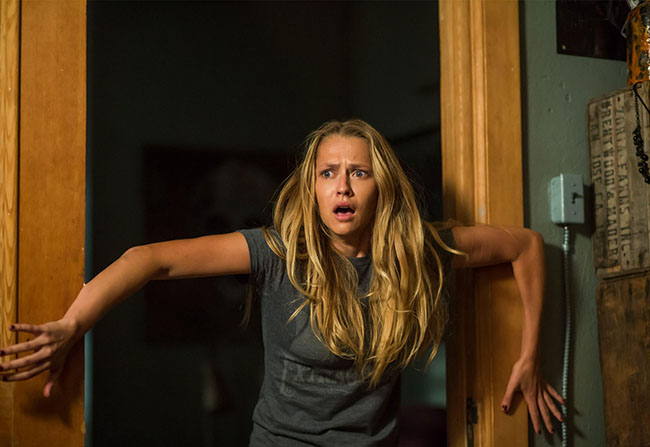It’s unbelievable that Lights Out didn’t exist until now.
Nearly everyone is afraid of the dark. When I first started watching horror movies, I slept with the lights on (ok, occasionally I still do) — why hadn’t a filmmaker directly exploited our infantile reliance on light yet?
Turns out the director of the fiendishly well-made Lights Out, David F. Sandberg, did so three years ago with a short film of the same name. The original Lights Out, made for a small film festival in Sweden, was not even three minutes long but managed to deliver a lean system of scares: a woman is haunted by a figure that can only appear when the lights are off. Simple, short, and effective.
Three years and a 5 million dollar budget later, Sandberg has the opportunity to frighten audiences with a feature length film based on his original concept. 2016’s Lights Out is still simple, but a good 80 minutes longer. Is it just as effective?
Definitely. Lights Out stretches its single idea a bit thin, but a compelling family and clever staging save it from darkness.
The monster of the original short remains the same — a demonic, feminine figure that can only fulfill its violent urges when the lights are out — but the subjects of its particular torture have changed. Lights Out follows a broken family: the emotionally closed-off Rebecca, her estranged and mentally ill mother Sophie, and her young half-brother Martin. After the creature begins haunting Martin in Sophie’s home and the disturbed mother seems oddly fine with the supernatural suffering, Rebecca attempts to protect Martin and discover what exactly is going on.
That may sound like artificial lengthening of a short film’s concept, but it’s actually the most gripping aspect of Lights Out. Screenwriter Eric Heisserer — perhaps taking a cue from producer James Wan’s The Conjuring — frames the horror in a family drama that demands care and empathy.
This should be partly accredited to a great cast. Teresa Palmer’s starring role as Rebecca is one of the more realistic horror heroines we’ve seen in a while, and Maria Bello’s performance as her mother adds a whole new layer of disconcerting. Newcomer Alexander DiPersia, who plays Rebecca’s (perhaps overly) dedicated boyfriend, finds a way to make his small part seem essential.
By carefully crafting characters before subjecting them to dread, Heisserer ensures that Lights Out is scary because we care about the people we don’t want opening the wrong doors.
Speaking of: as much as I love the characters, they tend to revert to idiocy to keep the movie going. A lot of terror could have been avoided had Rebecca and her gang not walked right past light switches or decided to explore every shadowy room. During the second half, the film finds humor in subverting and mocking this tendency though.
There’s no avoiding the feeling that the film devolves into the same jump scare repeated in different places. Light’s on, we feel safe; light goes out, woman leaps out and screams. Sandberg does manage to stage the last minutes differently enough to reach threat level terrifying, but it’s merely recycled goods shoved into a darker corner of the room.
Still, Lights Out is a shockingly good and decently scary experience. The fact that it feels complete despite its brief source material is a testament to Sandberg’s talent. Head into a dark theater for this one!
★★★½ (3.5 out of 5)




